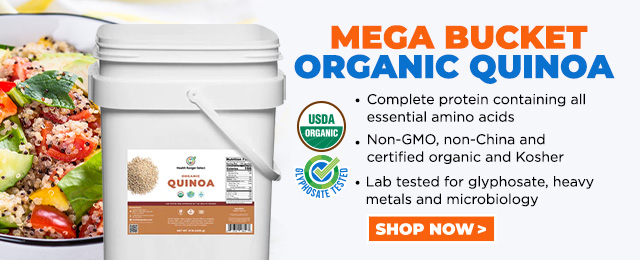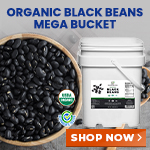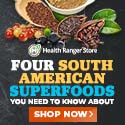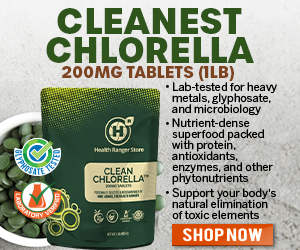
Fresh Vegetable Salads Provide Maximum Nutrition for Each Food Dollar Spent
Wednesday, February 25, 2009 by: Barbara L. Minton
Tags: salads, health news, Natural News
- Newly released JFK files reveal Pentagon's role in creating Lyme disease and covid in the same lab
- Dr. Suzanne Humphries makes bombshell appearance on Joe Rogan podcast, exposing vaccine industry deception back to POLIOMYELITIS
- L.A.'s rebuilding nightmare: Only 4 permits issued after fire destroys 6,000 homes
- Discovery of vast underground city beneath Giza pyramids challenges human history
- Black cumin seed oil emerges as a powerful ally against breast cancer and chronic inflammation
- “Independent” anti-Russia outlet MEDUZA faces COLLAPSE as US funding dries up
- Catastrophic 7.7 earthquake devastates Myanmar and Thailand; death toll could reach 100,000
- The hidden battle in your glass: How A1 and A2 milk could shape your health
- AI breakthrough slashes celiac disease diagnosis time from months to minutes
- BPA: The hidden hormone disruptor sabotaging your health - and how to fight back
- Sugar-free deception: Artificial sweeteners hijack hunger signals, fuel obesity epidemic, study warns
- Europe braces for WAR as EU urges citizens to STOCKPILE FOOD, in latest provocations with Russia
- Putin vows to 'finish off' Ukraine, accuses West of prolonging the war
- Thomas Massie’s Dual Loyalty Disclosure Act aims to restore American sovereignty by cracking down on foreign influence in Congress
- Aluminum pollution: A silent threat to human health
- Tesla owners under siege: Road rage, vandalism and political backlash fuel fear among drivers nationwide
- Chaos in Amsterdam: Five injured in broad daylight knife attack near Dam Square
- "Feel G.O.O.D. Gut Health Program" on BrightU: Dr. Basima Williams introduces the Feel-Good Plate Method
- Newly released JFK files reveal Pentagon's role in creating Lyme disease and covid in the same lab
- Analysis: The coming economic collapse, a mass uprising and Trump's three secret weapons to halt the growing revolt
- Festive flavors: The sweet history, nutritional profile and health benefits of pecan pie
- Elon Musk: Aliens could be here on Earth RIGHT NOW
- Trump reverses course on Gaza plan, says “nobody is expelling Palestinians”
- Big Pharma's $8 Billion bribery scheme exposed: how doctors are pushed to prescribe junk science, not heal
- Boys are back in town: Trump’s patriotic alpha crew takes the wheel while toxic females ride in the backseat
- Reclaim your health: How midlife exercise reverses years of inactivity
- A lack of integrity in Academia: Harvard professor found GUILTY of fraudulent research to promote CRT theory
- Survival 101: Effective EMF blocking techniques
- EPA advisor admits the agency is funneling billions to climate groups ahead of Trump’s return to White House
- Dr. Mike Yeadon releases 15-minute testimony - WATCH - about genocidal intent of COVID “vaccines”
- 5 Simple steps to boost your brainpower: How to strengthen executive function in a distracted world
- Florida takes a stand: DeSantis proposes permanent ban on mRNA vaccine mandates
- Sugarcane extract superior to cholesterol-lowering drugs?
- Mike Adams Sermon 66: God will DESTROY ISRAEL for its wickedness
- Pilots report mysterious lights 'moving at extreme speeds' across Oregon skies
- Space war brewing? Russia threatens to destroy Starlink satellites
- EPA advisor admits the agency is funneling billions to climate groups ahead of Trump’s return to White House
- California's social media censorship law struck down: A victory for free speech or a threat to online safety?
- The Health Ranger releases “Vaccine Zombie” song and music video, using AI-animated zombies for the music video
- Dr. Mike Yeadon releases 15-minute testimony - WATCH - about genocidal intent of COVID “vaccines”
- The pandemic as a tool for INDOCTRINATION: Understanding “The Indoctrinated Brain” by Dr. Michael Nehls
- Newly released JFK files reveal Pentagon's role in creating Lyme disease and covid in the same lab
- Florida takes a stand: DeSantis proposes permanent ban on mRNA vaccine mandates
- Mike Adams releases country western hit single: Goin’ Back in Time is Comin’ Home
- Mike Adams releases music poetry sensation: A Child of God
- “Why we influenced the 2020 elections”: Facebook files reveal the coordinated effort to bury the Hunter Biden laptop story
- Unpacking the Lies That We’ve Been Fed – new song and music video released by Mike Adams, the Health Ranger
- RFK Jr. clears key hurdle: Sen. Susan Collins backs controversial HHS nominee, signaling a new era for health policy
- Mike Adams releases new song and music video: Nothing More Disgusting Than a Globalist
- Michigan sheriff announces criminal investigation into 2020 election crimes, Dominion Voting Systems
- Israeli soldiers accused of even more torture and abuse in the West Bank
- Migrants are taking advantage of recent hurricanes to scam residents and loot their homes
- House Intelligence Committee calls for the ARREST and PROSECUTION of Dr. Anthony Fauci
- Rep. Nancy Mace introduces bill to ban biological males from female facilities on federal property
- Red Cross issues warning to stop blood plasma donations from vaccinated people
- Scientists confirm: GENIUS brain function can be spontaneously unleashed in humans without any apparent cause
- EPA advisor admits the agency is funneling billions to climate groups ahead of Trump’s return to White House
- HYSSOP: What research reveals about the health benefits of this ancient holy herb
- Two containers with completed ballots fall out of truck in Florida
- Fully vaccinated about to see “tsunami” of illness and death, warns virologist
- Global leaders unite to clamp down on “misinformation” with UN-backed Cascais Declaration
- BREAKING: 2025 NDAA authorizes mandatory military draft of WOMEN across America… as Pentagon pursues global NUCLEAR war with both Russia and China at the same time
- Michael Yon warns of a ZIONIST TAKEOVER in Trump’s second administration
- BOMBSHELL: DNA testing kits are a SCAM to develop ethnic-specific bioweapons
- Ozempic and Wegovy weight loss drugs are injectable LIZARD VENOM PEPTIDES that may unleash a devastating wave of organ failure… side effects align with symptoms of SNAKE BITES
- Israeli soldiers accused of even more torture and abuse in the West Bank
- These 13 countries just signed an agreement to engineer a global FAMINE by destroying food supply
- NASA admits that climate change occurs because of changes in Earth’s solar orbit, and NOT because of SUVs and fossil fuels
- RFK Jr. clears key hurdle: Sen. Susan Collins backs controversial HHS nominee, signaling a new era for health policy
- Sermon 30: How Jesus reveals Caesar’s FAKE CURRENCY and FALSE AUTHORITY
- Coriander seeds: Ancient medicine backed by modern science
- Arizona officials claim Maricopa County needs 10-13 days to tabulate results of the election
Salads that offer the most nutrition for the money are made with fresh, unprocessed vegetables. Color is the key. Those veggies with the bright, vibrant colors are trying to tell you something. The more colors added to the bowl, the more the salad can keep you looking and feeling young, and put a bounce in your step for the rest of the day. That's because vibrant colored veggies are loaded with antioxidants, plant compounds that slow the aging process and ward off disease.
Give your salad a solid foundation
Get your salad off to a good nutritional start by making a bed of leafy dark green vegetables. Lettuce is the traditional favorite, but stay away from the iceberg variety. Its lighter color gives it away as being low on nutritional value. Choose instead from romaine, green leaf lettuce, and spinach. Better yet, mix in some of each. Baby greens, sometimes called spring mix, are a good choice too.
All of these varieties are excellent sources of Vitamins A, E and K. Vitamin A supports eye and respiratory health, and makes sure the immune system is up to speed. It keeps the outer layers of tissues and organs healthy, and promotes strong bones, healthy skin and hair, and strong teeth. Vitamin E slows the aging process, maintains positive cholesterol ratios, provides endurance boosting oxygen, protects lungs from pollution, prevents various forms of cancer, and alleviates fatigue. Vitamin K keeps blood vessels strong and prevents blood clots.
Greens are also excellent sources of folate, manganese, chromium, and potassium. Folate prevents heart disease, defends against intestinal parasites and food poisoning, promotes healthy skin, and helps maintain hair color. Manganese keeps fatigue away, helps muscle reflexes and coordination, boosts memory, and helps prevent osteoporosis. Chromium helps normalize blood pressure and insulin levels. It prevents sugar cravings and sudden drops in energy. Potassium regulates the body's water balance and normalizes heart rhythms. It aids in clear thinking by sending oxygen to the brain.
Other green veggies offering big nutritional bangs are broccoli, green peppers, parsley, zucchini, asparagus, cucumber, okra, arugula, and sea vegetables.
Pile on all the colors to stay looking and feeling young
Load up your salad bowl with yellow vegetables like carrots, yellow peppers, sweet potatoes, and yellow summer squash. These are super rich in beta carotene, and vitamins A and C. They are powerful free radical scavengers that prevent damage to cells. Free radicals are thought to be responsible for clogged arteries and heart disease, cataracts, blood vessel damage, inflammatory diseases and arthritis, asthma, and even cancer. Vitamin C plays a big role in the formation of collagen, which is important for the growth and repair of body-tissue cells, gums, blood vessels, bones, and teeth. It helps keep the skin young and supple so wrinkles don't develop.
Purple cabbage, purple endive, and eggplant are rich in the phytonutrient anthocyanin, another type of flavonoid that fights the damage to cells that comes from daily living. Besides making the salad look absolutely gorgeous, purple cabbage is able to signal genes to increase production of enzymes involved in detoxification, the cleansing process that eliminates harmful compounds from the body. This means free radicals, carcinogens, and toxins are disarmed and cleared from organs and tissues. Studies have shown that people who eat the most cruciferous vegetables like purple cabbage and broccoli have a much lower risk of several cancers including breast cancer. These veggies promote gastrointestinal health, and a clean and healthy liver. They keep away ulcers, and even help prevent Alzheimer's disease through the ability of anthocyanins to protect brain cells against the damage caused by amyloid-beta protein.
Be sure to include some red in the salad. Along with being rich in vitamin C, tomatoes provide high levels of the carotenoid lycopene, known for preventing and fighting prostate cancer. Coumaric and chlorogenic acids found in tomatoes help keep lungs healthy even in smokers by blocking the effects of carcinogenic nitrosamines found in cigarette smoke. The carcinogenic effects of eating meats preserved with sodium nitrates can be blocked by adding tomatoes. Beets are another great red choice. Throughout history they have been used to detoxify and build the blood. Beets are high in folic acid, iron, and calcium. They contain betaine, a compound that detoxifies the liver and protects the liver and bile ducts from free radical damage. Studies show betaine contributes to coronary and cerebral artery health, and shrinks tumors.
Other red veggies with big nutritional powers are radishes, red bell peppers, chili peppers, red onions, and radicchio.
Many white foods are wastelands of nutrition. Not so for veggies. Cauliflower has many of the nutrients of other cruciferous vegetables. Onions and garlic are considered super foods for their potent health benefits that include high amounts of sulfur that protect collagen and connective tissues. Sulphur helps keep joints working well and hair looking shiny and healthy. Onions are considered a prebiotic, meaning they feed the probiotic bacteria and yeast in the intestinal tract. Both onion and garlic are known for lowering blood sugar levels and fighting inflammation, as well as having strong antibiotic properties that can be used to fight infections. They lower high cholesterol and blood pressure, help prevent heart attack and stroke, reduce colon cancer risk, and halt tumor growth.
Other white foods that go great in a healthy salad are mushrooms, jicama, and daikon.
Chopped salad gives the digestive system a head start
Chopped salads are popular fare in many restaurants that cater to people looking for a healthy meal. Chopping salad ingredients into very small pieces adds taste appeal because some of each ingredient is available in every bite. This means that a bit of each sweet ingredient like carrots, bell peppers and beets is included in each forkful, and all the flavors of the salad are included with each bite.
Lunch is often eaten in a rush, and big chunks of veggies can make for an afternoon of digestive unease. Chopping a salad gives the digestive system a head start on its work of breaking down all the components and releasing their nutrients. It is a waste of food dollars to buy a salad and not get the full nutritional benefit it has to offer. Chopped salad fits nicely into the mouth and allows for adequate chewing, so necessary for complete digestion.
If the salad is made at home, each ingredient can be chopped into very small pieces as it is added. If the salad is from a salad bar, chances are the veggies will be in large chunks, since chopping salad requires extra labor. After you have filled your bowl, grab a knife and fork and start chopping. As the afternoon wears on, you will probably be glad you did.
How the salad is dressed makes all the difference
What you put on your salad is just as important as what you put in it. Most dressings sold in traditional and health food grocery stores are made with polyunsaturated oil, an oil that deadens cellular energy and promotes vitamin D deficiency by decreasing the ability of vitamin D to bind with D binding proteins. Polyunsaturated oils have been linked to a variety of diseases ranging from digestive disorders to cancer. Most of these dressings also contain the excitotoxin monosodium glutamate, a compound that tricks the brain into believing cheap ingredients taste really great. Monosodium glutamate is toxic to brain cells.
Instead of reducing the nutritional punch of a salad, increase it with a dressing made from extra virgin olive oil and lemon juice or vinegar. Fresh vegetables and olive oil are part of the basics of the anti-aging and longevity-enhancing Mediterranean Diet. Instead of deadening cellular energy, olive oil actually increases it through its antioxidant capabilities. Olive oil has been around for thousands of years. It contains monounsaturated fatty acids and has a health profile that is far superior to newcomer canola oil. Choose natural vinegars without the addition of preservative sulfites. Read the label before you buy. Raw apple cider vinegar is a good choice, or squeeze on some fresh lemon juice.
Add herbs, fresh chopped garlic if you like, and a good pinch of sea salt to the dressing and mix it well. Dressing made with olive oil is so health promoting that it should be added liberally to the salad. Mix it up until dressing coats every tiny piece and the salad glistens with goodness. The salt helps release the juices from the vegetables adding even more flavor to the dressing and increasing digestibility.
What to add and what to avoid
A salad made with a large bed of dark green leafy vegetables contains some protein and a good amount of amino acids. The protein content of a salad can be beefed up by adding seeds and nuts. One ounce of pumpkin seeds or almonds boosts protein content by nine grams. Seeds and nuts add extra nutrition power and crunchy taste.
Adding sprouts is another good way to increase protein. Alfalfa sprouts are 35% protein. Broccoli sprouts are 26% protein and provide super antioxidant power as well as compounds known to prevent and fight many cancers including cancer of the breast.
Beans are another super nutritious choice, providing additional protein and nutrient power. If the salad is made at home, dried beans that have been soaked and cooked can be used. Prepared beans sold in glass jars work well too. Canned beans should be avoided unless cans are free of bisphenol-A.
Leave out the animal protein. Studies are suggesting that the polyphenols in vegetables bind with animal protein, making them inaccessible to the body. Polyphenols are largely responsible for the disease fighting capabilities of vegetables, so maintaining their integrity is important. As for cheese, it tastes really great in a salad, but studies have shown conclusively that polyphenols bind with milk protein.
If you are a salad bar visitor, those prepared salads look really tempting, but they are best left out too. They contain mayonnaise or other energy deadening dressings made with polyunsaturated oils. Many of them also contain monosodium glutamate and preservatives.
For more information see:
http://www.newswise.com/articles/view/523785...
M. Bunning and P. Kendall, Health Benefits and Safe Handling of Salad Greens, Colorado State University.
Earl Mindell's Vitamin Bible.
About the author
Barbara is a school psychologist, a published author in the area of personal finance, a breast cancer survivor using "alternative" treatments, a born existentialist, and a student of nature and all things natural.Salads at FETCH.news
Get independent news alerts on natural cures, food lab tests, cannabis medicine, science, robotics, drones, privacy and more.
Take Action: Support Natural News by linking to this article from your website
Permalink to this article:
Embed article link: (copy HTML code below):
Reprinting this article:
Non-commercial use OK, cite NaturalNews.com with clickable link.
Follow Natural News on Facebook, Twitter, Google Plus, and Pinterest
Science News & Studies
Medicine News and Information
Food News & Studies
Health News & Studies
Herbs News & Information
Pollution News & Studies
Cancer News & Studies
Climate News & Studies
Survival News & Information
Gear News & Information
News covering technology, stocks, hackers, and more



"Big Tech and mainstream media are constantly trying to silence the independent voices that dare to bring you the truth about toxic food ingredients, dangerous medications and the failed, fraudulent science of the profit-driven medical establishment.
Email is one of the best ways to make sure you stay informed, without the censorship of the tech giants (Google, Apple, Facebook, Twitter, YouTube, etc.). Stay informed and you'll even likely learn information that may help save your own life."
–The Health Ranger, Mike Adams












































